The Dried Honey Market is estimated to be valued at USD 979.8 million in 2025 and is projected to reach USD 2095.9 million by 2035, registering a compound annual growth rate (CAGR) of 7.9% over the forecast period.
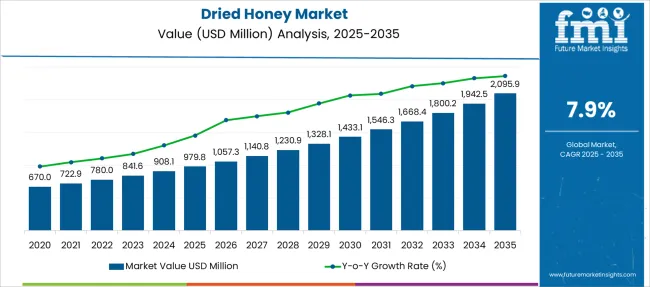
| Metric | Value |
|---|---|
| Dried Honey Market Estimated Value in (2025 E) | USD 979.8 million |
| Dried Honey Market Forecast Value in (2035 F) | USD 2095.9 million |
| Forecast CAGR (2025 to 2035) | 7.9% |
The dried honey market is experiencing consistent expansion as manufacturers and end users increasingly prioritize clean-label, functional ingredients that offer both extended shelf life and natural sweetness. Unlike liquid honey, dried honey is gaining popularity for its ease of transport, precision in formulation, and resistance to microbial spoilage, making it suitable for large-scale processing.
The rising demand for low-moisture ingredients in ready-to-eat, snack, and baking applications is reinforcing the relevance of dried honey across multiple food categories. Product developers are integrating dried honey into nutraceuticals, cereal blends, and beverage premixes where consistency, dosage accuracy, and reduced stickiness are critical.
As the wellness economy expands and consumer attention shifts toward minimally processed and naturally derived products, dried honey’s appeal as a high-flavor, low-water activity sweetener is growing Future growth is expected to be supported by sustainable sourcing practices, expanding organic certifications, and the increasing use of spray drying and vacuum drying technologies to preserve bioactive compounds and aroma integrity.
The market is segmented by Product Type, Nature, End Use, Flavours, and Form and region. By Product Type, the market is divided into Blend, Spray-Dried Honey, and Other Product Types. In terms of Nature, the market is classified into Organic and Conventional. Based on End Use, the market is segmented into Food and Beverages, Special Dietary Formulations, Vinaigrettes, Sauces, Brines, Marinades, Bakery Products, Confectionery, Glazes, Health Foods, Seasonings, and Dry Mixes. By Flavours, the market is divided into Honey (100%), Honey with Menthol, Honey with Lemon, Honey with Eucalyptus, and Honey with Other Flavours. By Form, the market is segmented into Powder and Granular. Regionally, the market is classified into North America, Latin America, Western Europe, Eastern Europe, Balkan & Baltic Countries, Russia & Belarus, Central Asia, East Asia, South Asia & Pacific, and the Middle East & Africa.
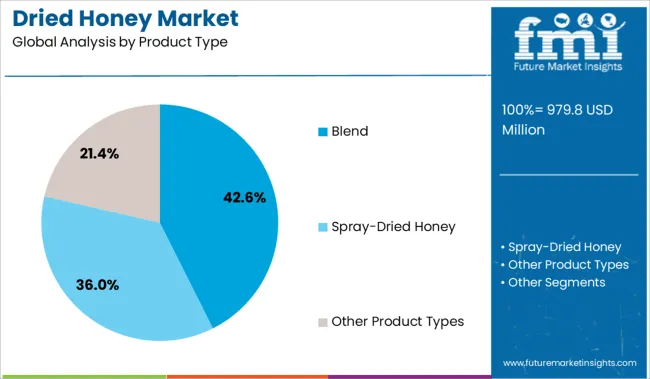
The blend segment is projected to hold 42.6% of the dried honey market revenue share in 2025, making it the dominant product type in this category. The prominence of this segment is being attributed to its cost-effectiveness, flavor consistency, and extended shelf stability compared to pure variants. Blended dried honey formulations typically combine honey with carrier substances such as maltodextrin or gum arabic, which enhance flow properties and prevent caking, especially in bulk industrial use.
These formulations are favored by food processors for their adaptability in powdered drink mixes, baking premixes, and cereal bars where moisture control and dispersibility are critical. The controlled sweetness profile and standardization offered by blends reduce batch variability, making them ideal for commercial-scale manufacturing.
Additionally, the ability to customize blends for specific flavor notes or nutritional requirements without compromising the clean-label positioning has increased their adoption Regulatory compliance, logistical efficiency, and reduced formulation costs have collectively positioned blended dried honey as a versatile and scalable solution in the market.
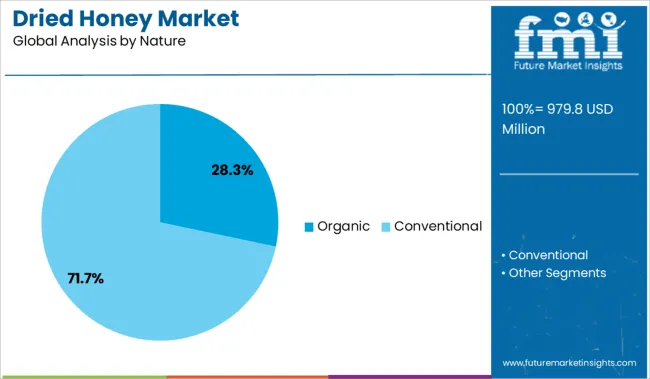
The organic segment is anticipated to account for 28.3% of the dried honey market’s revenue share in 2025, reflecting its growing acceptance among health-conscious and environmentally aware consumers. The segment’s expansion is being fueled by the increasing demand for pesticide-free, chemical-free ingredients that align with clean-label and sustainable consumption trends.
Organic dried honey has gained preference in food applications that emphasize ethical sourcing, traceability, and compliance with international organic standards. Consumers are increasingly seeking natural sweeteners that do not compromise on purity or nutritional value, and organic variants meet these expectations by ensuring the absence of synthetic additives and genetically modified organisms.
The integration of organic dried honey into functional foods, herbal teas, wellness beverages, and organic baked goods is rising, especially in premium and export-oriented markets As governments and certification bodies tighten regulations around organic labeling and traceability, the segment is expected to see further penetration across mainstream retail and specialty health food chains.
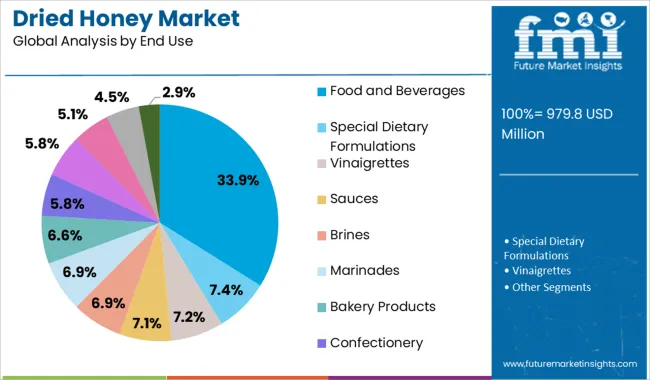
The food and beverages segment is expected to contribute 33.9% of the total revenue share in the dried honey market by 2025, establishing it as the leading end-use category. The segment’s leadership is being driven by the integration of dried honey in formulations where moisture sensitivity, flavor retention, and sugar replacement are critical.
Dried honey is widely used in bakery mixes, confectionery coatings, powdered beverages, snack bars, and dairy products where traditional liquid honey may disrupt texture or shelf life. The ability of dried honey to provide natural sweetness, binding properties, and aroma in dry formulations without the risk of crystallization has enhanced its application value.
The growth of plant-based and functional food categories has also contributed to the demand for dried honey as a complementary sweetener that aligns with health-forward branding Manufacturers in the food and beverage industry are increasingly opting for dried honey to meet consumer demand for recognizable, natural ingredients that do not compromise on performance or convenience.
In the past few years, the demand for dried honey is surging as interest grows in dry honey over conventional honey owing to the advantages it holds over conventional liquid honey, including convenience in transport and storage, etc.
Dried honey is inexpensive when compared to conventional honey and other sweeteners which is why more and more food service providers are incorporating it in their products instead of conventional sweeteners resulting in huge sales of dried honey.
The personal care and cosmetic industry are the ones spiking the demand for dried honey significantly.
Integration of dried honey in various cosmetics and personal care products is proliferating and providing the dried honey market share a substantial boost.
Dried honey is emerging as an important alternative to conventional liquid honey, Arabic gum, and other sweeteners, and is expected to elicit heft sales of dried honey over the forecast period.
However, the factors that could sink the sales of dried honey include problems of under or over-drying and the absence of pure honey.
The decline in the number of honey bee colonies is posing a challenge to the sales of dried honey and the same can be attributed to factors such as natural disasters and the effects of weather.
During the forecast period, the loss of honey bee colonies may limit the production of honey products such as dry honey, dwindling the overall dried honey market share.
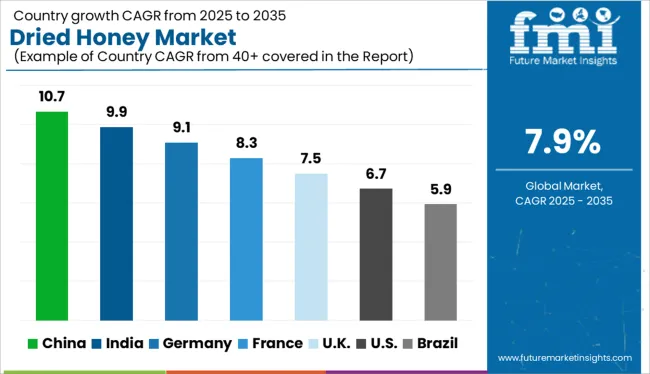
The dried honey market share of the Asia Pacific is quite high as China is the leading producer of honey with more than half a million tons in the year 2020.
Hence, the demand for dried honey in the Asia Pacific could flourish in the years to come.
In India as well, the production of natural honey is in abundance leading to a rising demand for dried honey.
The market in North America seems attractive too and with the incorporation of dried honey increasing in personal care and cosmetics, and various health foods as a growing interest in health-enhancing foods is observed in individuals, the sales of dried honey are likely to spike in the region.
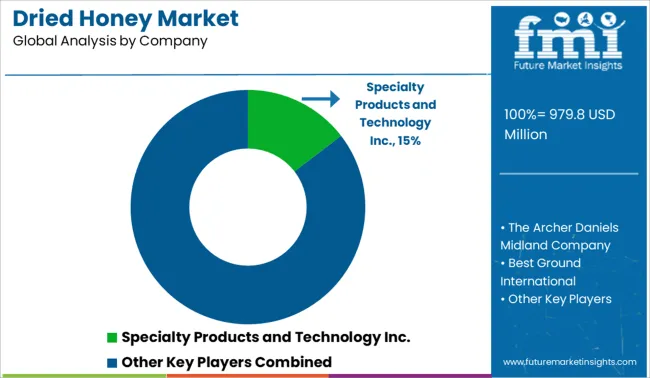
A few notable players in the dried honey market are Specialty Products and Technology Inc., Archer Daniels Midland Company, Best Ground International, Bio Botanica, Inc., Domino Specialty Ingredients (ASR Group), and Haldin Pacific Semesta.
Spice Jungle, LLC, Ohly (ABF Ingredients), Hoosier Hill Farm, Maple Leaf Garden Food Co., Island Abbey Foods Ltd., Wuhu Deli Foods Co., Ltd., Natural Sourcing LLC, Augason Farms are some other players.
These companies have a global presence and serve a diverse set of customers worldwide by meeting their demand for dried honey.
Many prominent market players have diverse product portfolios to meet changing consumer demand for dried honey.
| Report Attribute | Details |
|---|---|
| Growth Rate | CAGR of 7.9% from 2025 to 2035 |
| Base Year for Estimation | 2024 |
| Historical Data | 2014 to 2024 |
| Forecast Period | 2025 to 2035 |
| Quantitative Units | Revenue in USD Billion, Volume in Kilotons, and CAGR from 2025 to 2035 |
| Report Coverage | Revenue Forecast, Volume Forecast, Company Ranking, Competitive Landscape, Growth Factors, Trends, and Pricing Analysis |
| Segments Covered | Product Type, Nature, End Use, Flavors, Form, Sales Channel, Region |
| Regions Covered | North America; Latin America; Europe; East Asia; South Asia; Oceania; Middle East and Africa |
| Key Countries Profiled | USA, Canada, Brazil, Argentina, Germany, United Kingdom, France, Spain, Italy, Nordics, BENELUX, Australia & New Zealand, China, India, ASIAN, GCC Countries, South Africa |
| Key Companies Profiled | Specialty Products and Technology Inc.; The Archer Daniels Midland Company; Best Ground International; Bio Botanica, Inc.; Domino Specialty Ingredients (ASR Group); Haldin Pacific Semesta; Spice Jungle, LLC; Ohly (ABF Ingredients); Hoosier Hill Farm; Maple Leaf Garden Food Co.; Island Abbey Foods Ltd.; Wuhu Deli Foods Co., Ltd.; Natural Sourcing LLC |
| Customization | Available Upon Request |
The global dried honey market is estimated to be valued at USD 979.8 million in 2025.
The market size for the dried honey market is projected to reach USD 2,095.9 million by 2035.
The dried honey market is expected to grow at a 7.9% CAGR between 2025 and 2035.
The key product types in dried honey market are blend, spray-dried honey and other product types.
In terms of nature, organic segment to command 28.3% share in the dried honey market in 2025.






Full Research Suite comprises of:
Market outlook & trends analysis
Interviews & case studies
Strategic recommendations
Vendor profiles & capabilities analysis
5-year forecasts
8 regions and 60+ country-level data splits
Market segment data splits
12 months of continuous data updates
DELIVERED AS:
PDF EXCEL ONLINE
Dried Baby Food Market Size and Share Forecast Outlook 2025 to 2035
Dried Herbs Market Size and Share Forecast Outlook 2025 to 2035
Dried Soup Market Size, Growth, and Forecast for 2025 to 2035
Dried Spices Market Analysis by Type, End-Use Industry, Distribution Channel and Others Through 2035
Dried Spent Grain Market Trends – Growth & Industry Forecast 2025 to 2035
Dried Eggs Market Insights – Shelf-Stable Nutrition & Industry Growth 2025 to 2035
Dried Apricot Market - Growth, Demand & Nutritional Trends
Dried Mushrooms Market Analysis – Trends & Forecast 2024-2034
Dried Distillers' Grains with Soluble Market
Air-dried Venison Dog Food Market Size and Share Forecast Outlook 2025 to 2035
Air-dried Fish Dog Food Market Size and Share Forecast Outlook 2025 to 2035
Air-dried Chicken Dog Food Market Size and Share Forecast Outlook 2025 to 2035
Air-Dried Food Market Growth, Forecast, and Analysis 2025 to 2035
Roll-dried Starch Market Size and Share Forecast Outlook 2025 to 2035
Spray-dried Animal Plasma (SDAP) Market Size and Share Forecast Outlook 2025 to 2035
Spray Dried Food Market Analysis - Size, Share, and Forecast Outlook 2025 to 2035
Freeze Dried Fruit Powder Market Size and Share Forecast Outlook 2025 to 2035
Rolled-Dried Starch Market Size and Share Forecast Outlook 2025 to 2035
Freeze-dried Food Market Analysis - Size, Growth, and Forecast 2025 to 2035
Freeze Dried Fruits Market Analysis - Size, Share, and Forecast Outlook 2025 to 2035

Thank you!
You will receive an email from our Business Development Manager. Please be sure to check your SPAM/JUNK folder too.
Chat With
MaRIA